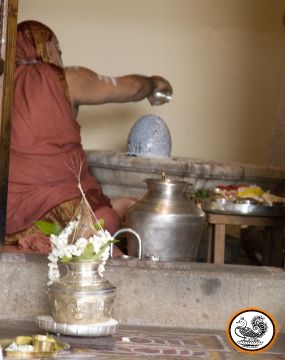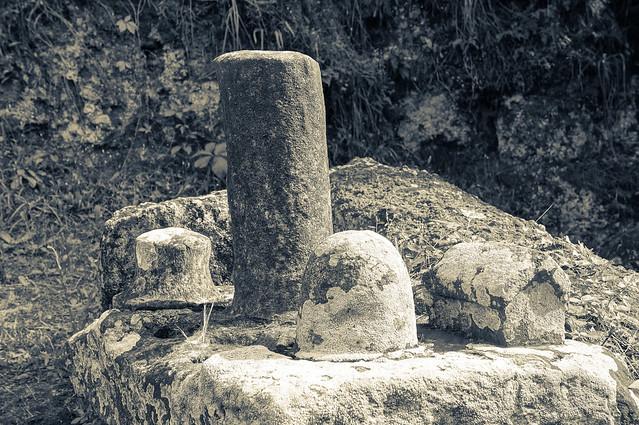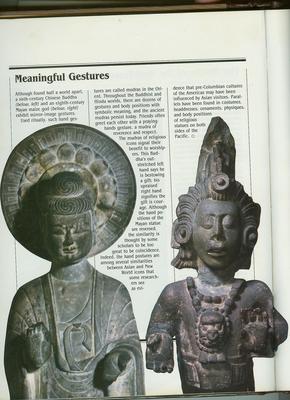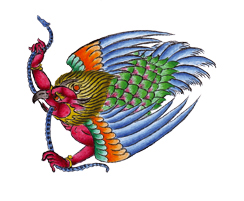RajeshA wrote:shiv saar,
from all our studies so far in context of this thread and beyond, I think one thing one can say for certainty - History as espoused by Europeans is at its core an effort to prove their superiority - either through reconstructed, nay re-imagined past full of glory; or simply through their domination in their scholarship of various ancient civilizations, thus claiming them as part of the universalism of their civilization; or by taking credit for the achievements of others.
Their second great accomplishment has been to whitewash their own history of plunder and genocide by wrapping their barbarism and greed in eloquent language as deeds of exploration, valor, liberation and education.
It is with this insight that we should look upon the works of European historians, and try to build a solid new edifice of history keeping Satyamev Jayate front and center of the new effort. We have to treat everything touched by a European historian as contaminated by prejudice and use that as a filter to adjudge their works, sieving out the substance from their propaganda.
We Indians have shown too much of deference and awe to European names. Even today, even we here on this thread, are not completely freed from this attitude. Our fight against AIT still presupposes a behemoth of "good" European scholarship as our adversary and we still lack the confidence to call it a pack of see-through lies put together by some eloquent fiction-writers.
It does not free us from our duty to expose these "see-through" lies for they are as yet not quite visible to all, considering that these lies have been cleverly buried in a web of cross-references in so called scholarship as well as incessant repetitions of falsehoods.
Normally we are accustomed to accepting the statements of others in these matters as his best judgment and if the name has some fame, we consider it as as close to truth as possible. We don't by nature consider the other as telling lies, knowingly or unknowingly. So the European recipe has always been quite simple - to promote their people as scholars of high repute and then to give them a platform for telling lies about history. We Indians fall for this quite easily. Often many simply wish to identify themselves with a "superior" system of European "truth-telling", rather than hopping into the trenches and finding out the truth for themselves, or accepting what other SDRE Indians have discovered if it contradicts European "truths".
Sorry for the little rant directed at us in general, but AIT is as much about freeing Indians from the "mesmerizing" European narrative as it is about the truth itself.
+108, saar. This post must be the first post of this thread, nay, the first post that everyone(not just indians) must read before studying anything on history(or even religion or culture for that matter because all of them inter-connected).
The big problem is that all of us are seeing the world through the eyes of the colonial european constructs. For example: Africans learn about India through colonial europeans. Indians learn about Americans(the original ones) through colonial europeans. And so on.
These colonial europeans have muddied the waters completely. Otherwise, if there was a direct contact, I think it is very easy to see that most of the ancient civilizations have same social and religious concepts with some local variations. Perhaps, the world was always inter-connected, just as it is today.
Colonial europeans with their ridiculous history based on biblical theology complicated the things. Their conclusions and views must be summarily dismissed. Even their data-points must be accepted only after they are independently corroborated.
Today, this problem has evolved further... Not only do people look at each other through the eyes of colonial europeans, but they are starting to look at their own culture and society through eyes of colonial europeans. In particular, this is the bane of Indian history, culture, and religion.
People give more weight-age to the half-baked views of some unwashed colonial, instead of the traditional scholar. For evidence, just visit epics thread and discussion on Draupadi based on Randomoozham or Narendra Kohli's Mahasamar. I get the feeling that works like Randomoozham and Mahasamar depict the true impact of colonials on Indians. The colonials have been successful in making Indians consider other half-baked theories as more relevant, then what is mentioned in the original scriptures.
It has become 'rational' and 'modern' to interpret the grand scriptures to suit one's own mundane existence and bias. So, instead of accepting the work as it is, it is deconstructed. The same people hold even silly works of the colonials over and above criticism(even when the criticism is well-founded). Remember the takleef to some when Conan Doyle's racism(specially directed at Indians) was discussed in UK thread?!
This is the true impact of the colonial work. I think this phenomenon is not limited to India. It is high time that Indians must reject all the narratives put forth by the colonials. And I agree with you that traditional dating should always be given higher priority than the dates colonials(or their heirs) have come up with.
Having said that, it seems Shiv saar, has some piskological game in mind. Maybe his method will have success...
I think we(as anti-AIT or pro-OIT), should not be tied down to one method or even a narrative. Each one can poke holes into the establishment theory(AIT) in our own ways. You never know which one will hit the bull's eye... So, we should throw all we got and then something will stick. Also, different people are convinced by different kind of arguments. So, multiple arguments are also good from that point of view.
But primary focus must be on negating AIT. OIT need not have a structured narrative at all... atleast, not at the early stage. One only needs to show that various cultures around the world have Indian link. The narrative can be formed and reformed at a later stage.
RajeshA wrote:johneeG ji,
whenever I read your posts, I often think of the saying "Sau Sunaar ki, to ek lauhaar ki"!

Thanks for your efforts!
Thanks so much for that praise, RajeshA ji. Thanks a lot...

---
anupmisra ji,
I was wanting to post on that for sometime. Somehow, did not post it due to laziness.

Many Shivalingas are found in the so-called cemeteries of cervetri. The western historians are calling them as 'phalus' and they are supposed to have been erected on the tombs to indicate that male was in the tomb.
I find it strange that archeologists seem to find so many tombs and cemeteries only. They never find any corresponding palaces, temples, forts or any such other monuments. Only tombs and cemeteries...
There are three possibilities:
a) Ancient people were obsessed with tombs.
b) Modern archeologists(specially western ones) are obsessed with tombs.
c) Only tombs have survived while all other monuments have perished.
Modern historians want us to believe in (a) and (c). But, why would tombs survive while other monuments perish? Infact, it should be the other way around, no? I mean a temple or a palace must have more lifetime than a tomb(particularly if its some random citizen). A temple or a palace or a fort is again and again repaired by successive generations and used by them. On the other hand, a tomb is forgotten very quickly within a generation. So, how come that only tombs are found?
So, to me, (b) is a possibility. It is possible that it is the modern archeologist and historians who are obsessed with tombs. Their first instinct is to 'identify' any ancient monument as a 'tomb'. Why this obsession? It may have to do with the cultural background of the western historians, particularly those who started this fad(the colonial europeans). Colonial europeans with their X-ism background may have been prone to identify any monument with some scattered skeletal remains as a tomb or cemetery.
Leave that as it may...
In this particular case(etruscian excavations), they have come up with a weird explanation for finding Shivalinga(phallus) on the so-called 'tombs'. It seems the phallus indicates that the tomb belongs to a male. To me, this seems like a lahori logic...
The above conclusion becomes more absurd when we see that these 'tombs' are filled with colorful paintings(as if they are a temple).
Moreover, it is known that greeks and romans cremated their dead(until they were converted by the X-ians forcefully). Even Vikings cremated their dead(correct me if I am wrong). So, how come etruscians are burying their dead?!
Also, if we assume that etruscians buried their dead. Then, there must be many many tombs and cemeteries. Are so many tombs and cemeteries found?
By all these counts, I am inclined to believe that regular etruscian people were cremated and not buried. If we accept the monuments to be 'tombs', then they must be special people because they were buried and not cremated.
Anyway, in India, there is a tradition of combining 'tombs' and temples. Yep, 'tombs' of some people were treated as temples. For example, Raghavendra Swami at Mantralayam, AP.
Some background details are necessary to understand. Generally, Hindus cremate their dead. But, sanyasis(or monks) are not cremated. Instead, they are buried. This is an important point... and may have many connections.
There is an interesting point here. Among Vaishnavas, a tomb of a pontiff(or a sacred sanyasi) is called 'Brindavan'. On the top of a tomb, a tulsi is planted. And it is called a Brindavan. At Mantralayam, this is the procedure that is followed.
But, among others(specially, Advaitas), a shivlinga is erected on the top of the tomb. It is called as Adhishtana. This shivlinga is then worshiped. The monument built for this purpose is similar to temple architecture. This place is equivalent to a temple(but, it is also a tomb). People visit it as if its a regular temple and pray there. For example, in Sringeri, one will find Adhishtanas of many earlier Pontiffs. This seems to be the traditional vedic method.
Some place named Govindeshwar Gupha in MP:
Straight opposite to the entrance, one comes across a recent idol of Govindabhagawad pada. Behind him is carved on the cave wall, Govind Bhagavad pada and a young shankara who is taming the raging Narmada using his Kamandala. No idea how old that carving is. A thousand years maybe!

Towards the right, there's an opening with steps leeding further down.

A small chamber, and then at the extreme end there's further stairs leading further down. No windows or light. Didn't want to go down in utter darkness. Stopped here and turned back! It seemed like the cave was spiralling down to the river.

Old Adhishtana (in remembrance to a guru who's passed away. May be Govinda bhagavad pada himself?) Adhishtanas in earlier times were all shaped like Shiva lingams.
Link
This tradition continues in Sringeri:
The 130th Aradhana of the 32nd Acharya of the Peetham, Brahmibhuta Jagadguru Sri Narasimha Bharati Mahaswamiji was celebrated in Sringeri on May 26th. Jagadguru Sri Bharati Tirtha Mahaswamiji offered special worship at the Adhisthanam of His Parapara Guru.

Link
In the above pic, the present Pontiff of Sringeri is worshiping the Shivalinga that was erected on the 'tomb' of earlier Pontiff. This is a temple, for all intents and purposes.
Now, lets look at etruscian phallus'(Shivalinga):

More links to many Shivalingas found in cerveteri:
http://217.115.252.254:1572/Dokumenty%2 ... veteri.jpg
http://www.flickr.com/photos/roger_ulrich/6195624468/
Tomb Markers (cippi) from Cerveteri
An assortment of tomb markers (cippus, plural cippi), from the Etruscan Banditaccia necropolis of Cerveteri (Caere). These are no longer in situ. Markers like these, usually without any inscriptions or figural decoration, were set up on small stands before the doorways of chamber tombs.
http://www.flickr.com/photos/roger_ulrich/6195624468/
Tomb Markers (cippi) in situ from Cerveteri
A group of tomb markers (sing. cippus, plural cippi) in situ at the Etruscan Banditaccia necropolis of Caere/Cerveteri, Italy. These simple markers, the exact purpose of which is not known, were placed outside the tombs in the cemetery, Note the house-shaped cippus on the right.
Lets, look at the supposed cemetery:

It seems to me that the pillar in the above picture is uncannily similar to a pillar of any Indian temple.
Now, look at this picture of an etruscian 'tomb':

Link to bigger picture:
http://slinging.org/forum/yabbfiles/Att ... eliefs.jpg
This is unmistakably similar to a Hindu temple with a Shivalinga in the center.
Picture of the place from outside:

The other etruscian items that were found in archeological excavations are:

And another etruscian lion depiction:

This figure is very similar to south-Indian lion depictions.
For example, Lion pillar at Mahabalipuram:

Lion is frequently found in Indian architecture. Infact, Lion is seen as symbol of power(and royalty). Throne is called Simhasana or Lion-seat.
Another etruscian item that was found:
http://217.115.252.254:1572/Dokumenty%2 ... Museum.jpg
Etruscan pendant with swastika symbols, Bolsena, Italy, 700-650 BC. Louvre Museum.jpg
Another etruscian item is a chariot:
http://217.115.252.254:1572/Dokumenty%2 ... 0%20BC.jpg
Link
Konark temple with its wheel:

The upper part of etruscian chariot is similar to this toy version of Indian chariot:

India
Uttar Pradesh, Kaushambi
Toy Cart with Lion Charging a Warrior on the Side and Wheels with Lotus Motifs, 1st century B.C.
Partially molded terracotta with red slip
Height: 14 cm (5 1/2 in.)
Link
---
In short, the etruscian architecture has many similarities with ancient India. And there are also cultural and religious similarities(like worshiping cows, calves, bulls, horses and swastika).
Coming back to Shivalingas(or Phallus) on the tombs. This may have lead to modern-day grave-stone culture. That means, grave-stones are a 2-d versions of Shivalingas that used to be erected on the tombs of (spiritually)important people.
Finally, the etruscian excavations may not be mere tombs, but temple-tombs... similar to Indian culture.


















